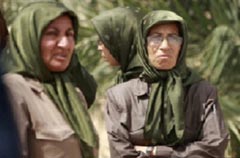Members of the Iranian dissident group known as the Mujahedin e-Khalq, or MEK, really don’t like me. I don’t trust them, either. I’ve been reporting on the MEK for the Huffington Post since last  summer, and members of the group have threatened my house and hacked my email.
summer, and members of the group have threatened my house and hacked my email.
Still, I believe the State Department’s decision Friday to remove the MEK from the list of Foreign Terrorist Organizations was a good one.
Like many people who’ve researched how the MEK actually works, I don’t believe that they’re freedom fighters in exile as they claim to be. Nor do I believe their values are democratic, as they claim they are.
I believe the MEK is a militant cult of personality, whose leaders, Maryam and Massoud Rajavi, figured out in the 1980’s that they could survive by doing mercenary work on behalf of governments that hate Iran. Saddam Hussein was their first patron, and he granted them land in Iraq to build a walled, military compound, Camp Ashraf, where until a few months ago, more than 3,000 members lived.
There, they would wake up every day and worship images of Maryam Rajavi before commencing with the day’s Army base-type tasks. The MEK claims to subsist on foreign contributions, but that’s only partly true.
In America, their well-paid U.S. advocates, men like former Pennsylvania Gov. Ed Rendell and former New York City mayor Rudy Giuliani, wax on about how the MEK renounced violence a decade ago and just needs U.S. backing in order to topple the Iranian regime and seize power. I’ve watched these guys earn $40,000 for an eight-minute speech.
But the debate over whether or not the MEK is a terrorist group doesn’t matter. It never really did. After dozens of conversations and background briefings over the past year, I don’t believe Secretary of State Hillary Clinton decided to delist the MEK how and when she did because the secretary suddenly changed her mind on the question of whether or not they are terrorists.
I think the reason the MEK was delisted on Friday is, more importantly, because Clinton understands that they’re a dangerous cult, and that all the other potential outcomes of the 30-year standoff between the MEK and the outside world would have likely been much, much worse.
Near the top of that list was mass suicide, a possibility that kept more than a few U.S. diplomats up at night. After that, it was that the MEK’s leaders would deliberately provoke a confrontation with Iraqi security forces, many of whom would be happy to avenge the ethnic cleansing raids MEK soldiers carried out for Hussein back in the day. In France, where Maryam Rajavi lives, officials considered the unwelcome possibility of public self-immolations — a tactic the MEK has used there before.
Truth is, most of the world doesn’t really care what happens to the 3,200 people who used to live at Camp Ashraf.
But Secretary Clinton cares, despite years of daily MEK protests outside her office on C Street, N.W., where I’ve watched the same dozen or so people, all dressed in identical Maryam Rajavi t-shirts, banging drums and accusing Clinton of violating human rights, breaking international law, and callously leaving them to die at the hands of Iraqi soldiers.
Ironically, while they cursed the secretary from the sidewalk, inside the State Department, Clinton and her aides were quietly working on a plan to save thousands of brainwashed MEK foot soldiers in Camp Ashraf from their own leaders and from the Iraqi military.
The only way to do this is to split the 3,200 into small groups and transfer them out of Iraq a few at a time, as refugees. This being a cult, however, the leaders initially refused to let anyone leave Ashraf unless they all left as a group. But as one former U.S. diplomat said to me, "What the hell kind of country is going to agree to take in 3,000 militant cult members?"
Clinton only had one major bargaining chip. In exchange for leaving Camp Ashraf, the secretary agreed to delist the group from the U.S. list of Foreign Terrorist Organizations, which she officially did on Friday. That afternoon, State Department officials presented us reporters with three reasons they said the decision was merited. None of the official reasons holds up to scrutiny, but the eventual outcome, the delisting, does.
Therein lies the difference between politics and diplomacy. The "reasons" given here didn’t win anybody over. They were more of a gesture meant to placate people like me, who have reported what everyone at the State Department already accepts, namely, that the MEK is dangerous and untrustworthy and capable of future violence.
But the question facing Secretary Clinton wasn’t whether the MEK could be trusted. Or even if the MEK’s members were still dangerous. Privately, U.S. officials don’t pretend to know the answer to either one.
The question at the heart of the MEK decision was whether Clinton would be willing to quietly save 3,200 lives. She was.
I may not trust the MEK or their tactics, but the year-long negotiation that culminated on Friday represents a bright point for U.S. diplomacy and humanitarianism.
By Christina Wilkie

